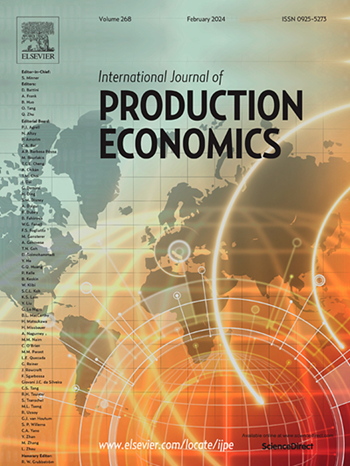ESG equity or green credit: Financing strategies for green transformation in the supply chain under consumption subsidies
IF 9.8
1区 工程技术
Q1 ENGINEERING, INDUSTRIAL
引用次数: 0
Abstract
We consider a supply chain with a capital-constrained supplier and a manufacturer, where the supplier seeks funding for green transformation. We develop an ESG Equity Financing (EEF) model that incorporates dividend ratios based on ESG valuation, reflecting both the supplier's financial and ESG performance. In addition to the EEF offered by the manufacturer, the supplier can opt for traditional Green Credit Financing (GCF) from banks. Under government subsidies for consumers buying green transformation products, we explore pricing strategies under different financing models and examine how subsidies impact green transformation, value creation, and financing equilibrium in the supply chain. We also compare the sustainability of EEF and GCF in driving green transformation. Our analysis reveals that consumption subsidies may not incentivize suppliers to increase green investments. In pricing strategies, GCF encourages both the supplier and manufacturer to raise prices, while EEF can lead the manufacturer to lower prices. Regarding financing equilibrium, the supplier's carbon emissions profile and subsidy rate significantly affect the balance between the two financing options. Interestingly, a higher degree of product greenness does not always result in lower overall carbon emissions. Most importantly, EEF has the potential to be the only financing strategy that creates a win-win outcome for the supply chain, consumers, and societal welfare. With suitable government interventions, particularly in setting consumption subsidies, EEF can emerge as the preferred financing option, facilitating green transformation and benefiting all stakeholders.
ESG股权还是绿色信贷:消费补贴下供应链绿色转型的融资策略
我们考虑一个供应链,其中有一个资金有限的供应商和一个制造商,其中供应商寻求绿色转型的资金。我们开发了一个ESG股权融资(EEF)模型,该模型结合了基于ESG估值的股息比率,反映了供应商的财务和ESG绩效。除了制造商提供的EEF外,供应商还可以选择传统的银行绿色信贷融资(GCF)。在政府补贴消费者购买绿色转型产品的情况下,我们探讨了不同融资模式下的定价策略,并考察了补贴对绿色转型、价值创造和供应链融资均衡的影响。我们还比较了绿色环境基金和绿色气候基金在推动绿色转型方面的可持续性。我们的分析表明,消费补贴可能不会激励供应商增加绿色投资。在定价策略上,GCF鼓励供应商和制造商都提高价格,而EEF可以引导制造商降低价格。在融资均衡方面,供应商的碳排放概况和补贴率显著影响两种融资方案之间的平衡。有趣的是,更高程度的产品绿色并不总是导致更低的总体碳排放。最重要的是,EEF有可能成为唯一一种为供应链、消费者和社会福利创造双赢结果的融资策略。在适当的政府干预下,特别是在设定消费补贴方面,EEF可以成为首选的融资选择,促进绿色转型,使所有利益相关者受益。
本文章由计算机程序翻译,如有差异,请以英文原文为准。
求助全文
约1分钟内获得全文
求助全文
来源期刊
CiteScore
21.40
自引率
7.50%
发文量
266
审稿时长
52 days
期刊介绍:
The International Journal of Production Economics focuses on the interface between engineering and management. It covers all aspects of manufacturing and process industries, as well as production in general. The journal is interdisciplinary, considering activities throughout the product life cycle and material flow cycle. It aims to disseminate knowledge for improving industrial practice and strengthening the theoretical base for decision making. The journal serves as a forum for exchanging ideas and presenting new developments in theory and application, combining academic standards with practical value for industrial applications.

 求助内容:
求助内容: 应助结果提醒方式:
应助结果提醒方式:


